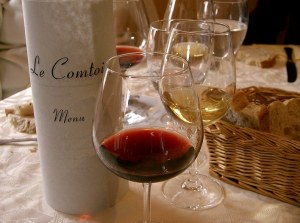Looking for something a little different to host this holiday season? How about a blind wine tasting party? Blind wine tastings can be a great way to learn about wine while having some bonding time with the ones you love. A blind wine tasting can help you discover new favorites and inexpensive bottles with expensive flavor. A blind wine tasting can help you decide what to serve at an upcoming dinner, party, or even wedding. And best of all, a
wine tasting is a great party catalyst, giving your guests something to talk and laugh about.
The powers of perception and expectation can play surprisingly large roles in our judgement of wine. Studies have proven that

people will rate a wine they were told was more expensive as better than the same wine labeled as a cheap bottle. A white wine will be judged as "fresh" and "clean," while the same wine dyed red will be judged as "bold" and "spicy." Think you're immune to this kind of fooling? Test yourself and your friends with a blind taste test!
Gather 6-12 wine lovers (any more and you'll have to buy two bottles of wine for each tasting) and pick out a few bottles of several different grape varietals, from different price points. Bag each bottle, making sure the bag is long and loose enough to conceal the bottle's shape (remember those powers of expectation). Group the bottles by grape varietal, and taste away. For serious wine connoisseurs, you can pass out pens and paper for note-taking, but for a more fun and casual atmosphere, let your guests chat away, and have everyone rank the wines in each group. You and your guests might be surprised by your choices!
A few tips for a perfect blind wine tasting:
- Tape or rubber band bags to bottles so they don't slip during pouring. (You can cover the tape or band with ribbon to make it more festive.)
- Serve something for your guests to nibble on, but choose a snack that won't interfere with the taste of the wines. Mild cheese and crackers is a good choice.
- Label your wines A, B, C etc, so you can tell them apart during discussion and ranking.
- Organize your tasting so that your guests move from sparkling, to white, to red, from sweet to dry, and from light-bodied to full-bodied.

 people will rate a wine they were told was more expensive as better than the same wine labeled as a cheap bottle. A white wine will be judged as "fresh" and "clean," while the same wine dyed red will be judged as "bold" and "spicy." Think you're immune to this kind of fooling? Test yourself and your friends with a blind taste test!
Gather 6-12 wine lovers (any more and you'll have to buy two bottles of wine for each tasting) and pick out a few bottles of several different grape varietals, from different price points. Bag each bottle, making sure the bag is long and loose enough to conceal the bottle's shape (remember those powers of expectation). Group the bottles by grape varietal, and taste away. For serious wine connoisseurs, you can pass out pens and paper for note-taking, but for a more fun and casual atmosphere, let your guests chat away, and have everyone rank the wines in each group. You and your guests might be surprised by your choices!
A few tips for a perfect blind wine tasting:
people will rate a wine they were told was more expensive as better than the same wine labeled as a cheap bottle. A white wine will be judged as "fresh" and "clean," while the same wine dyed red will be judged as "bold" and "spicy." Think you're immune to this kind of fooling? Test yourself and your friends with a blind taste test!
Gather 6-12 wine lovers (any more and you'll have to buy two bottles of wine for each tasting) and pick out a few bottles of several different grape varietals, from different price points. Bag each bottle, making sure the bag is long and loose enough to conceal the bottle's shape (remember those powers of expectation). Group the bottles by grape varietal, and taste away. For serious wine connoisseurs, you can pass out pens and paper for note-taking, but for a more fun and casual atmosphere, let your guests chat away, and have everyone rank the wines in each group. You and your guests might be surprised by your choices!
A few tips for a perfect blind wine tasting:
